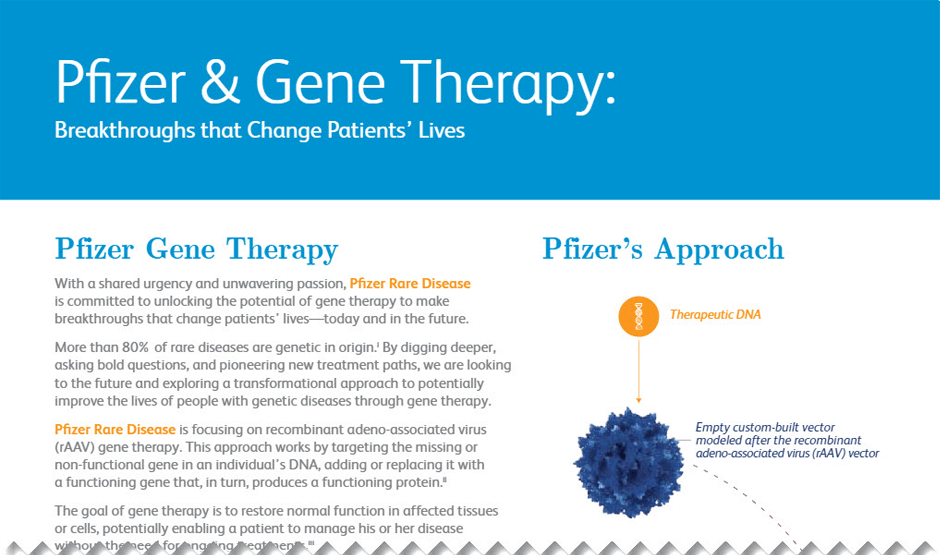Gene Therapy: Genes As Medicine
Gene therapy is the next generation of medicine targeting the underlying cause of a genetic disease. It has the potential to offer patients a transformational clinical benefit and dramatically improve quality of life.
- What is a Gene?
A gene is the basic physical and functional unit of heredity, and is made up of DNA.1 The Human Genome Project estimated that humans have between 20,000 and 25,000 genes.1 Though small, our genes are a blueprint for how each cell in the body functions, made up of 30 million codes of DNA.2
- What is a Genetic Disease?
A genetic disease is caused by an alteration in an individual’s DNA, oftentimes inherited or, in rare cases, occurring spontaneously.3 Genes play an essential role in determining the function of each cell in the body, made up of 30 million codes of DNA.1,2 If even one of these codes is damaged, a gene alteration may occur causing a genetic disease,3 some of which can be debilitating and life-threatening.4
- What is Gene Therapy?
Gene therapy is a new generation of medicine where a functioning gene is delivered to a targeted tissue in the body to produce a missing or nonfunctioning protein. By using genes as medicine, the underlying cause of a disease can be targeted at the cellular level, potentially with just one treatment.5,6,7
- What is in vivo Gene Therapy? What is ex vivo Gene Therapy?
For in vivo, the functioning gene is transferred to the cell inside the body via an infusion and is used as a blueprint to produce the missing or nonfunctioning protein.8 For ex vivo, patient’s cells are removed and exposed to the desired gene outside of the body, then re-infused to add the functioning gene back in the body.9
- What is Gene Editing?
Gene editing is a precise change of a patient’s DNA using site-specific, targeted nucleases (eg, CRISPR, Zinc Finger).10,11 This approach either permanently removes or modifies a gene, or adds a functioning gene within the patient’s body.10
- Are There Other Genetic Approaches?
Another approach uses RNAi technology to change the expression of a gene by targeting product of DNA transcription (RNA). This approach more or less “silences” the dysfunctional gene attributed to the genetic disease.12
GENE THERAPY: FREQUENTLY ASKED QUESTIONS
- What are the potential benefits of gene therapy?
Unlike traditional medications, which often require frequent administration and focus on managing symptoms and disease progression, gene therapy aims to address the non-functioning gene and provide a long-term treatment benefit with potentially just one dose.5,6,7
However, while gene therapy holds promise for people with genetic diseases, it will not be an appropriate solution for every patient. The potential risks and benefits of gene therapy will emerge with continued research and evaluation.13
- What are the potential challenges of gene therapy?
Some patients may have been exposed to AAV and may have developed antibodies to this virus and therefore would not be a candidate for treatment. These patients may develop an immune response immediately post treatment, where the body neutralizes the therapeutic gene’s function.13 If caught early, clinical experience shows these responses may be able to be treated with steroids, potentially leading to a stabilization of the gene’s functioning.14
- How do you know if you may be eligible for gene therapy?
Eligibility for gene therapy treatments will be determined by a number of criteria, including a blood test to check for antibodies to the custom vector. Patients can discuss the test criteria and results with their physicians and determine how to proceed on an individual basis.15,16 Factors that may make someone ineligible to receive gene therapy treatment include patients with preexisting antibodies that would neutralize the specific gene therapy treatment, patients who have previously received gene therapy and developed these antibodies, and for certain diseases, the age of the patient at the time of treatment.
- How long does gene therapy last?
Clinical trials are currently underway to explore the many unknowns, including how long a particular gene therapy may last.15 That said, evidence to date indicates gene therapy has the potential to increase or restore function in affected tissues or cells over a long period of time and may enable a patient to manage his or her disease without the need for ongoing treatments.
References:
1. NIH Genetics Home Reference. What is a Gene? https://ghr.nlm.nih.gov/primer/basics/gene. Accessed February 10, 2020.
2. Forbes. How Many Possible Combinations of DNA Are There? https://www.forbes.com/sites/quora/2017/01/20/how-many-possible-combinations-of-dna-are-there/. Accessed February 10, 2020.
3. NIH National Human Genome Research Institute. Genetic Disorders. https://www.genome.gov/For-Patients-and-Families/Genetic-Disorders. Accessed February 10, 2020.
4. NIH Genetics Home Reference. How Can Gene Mutations Affect Health and Development? https://ghr.nlm.nih.gov/primer/mutationsanddisorders/mutationscausedisease. Accessed February 10, 2020.
5. NIH Genetics Home Reference. How does Gene Therapy Work? https://ghr.nlm.nih.gov/primer/therapy/procedures. Accessed February 10, 2020.
6. NIH Genetics Home Reference. What is Gene Therapy? https://ghr.nlm.nih.gov/primer/therapy/genetherapy. Accessed February 10, 2020.
7. Data on file. Pfizer Inc, New York, NY.
8. Haasteren J, Hyde S, Gill D. Lessons Learned From Lung and Liver In-Vivo Gene Therapy: Implications for the Future. Expert Opin Biol Ther. 2018;18(9):959-972.
9. Gowing G, Svendsen S, Svendsen CS. Ex Vivo Gene Therapy for the Treatment of Neurological Disorders. Prog Brain Res. 2017;230:99-132.
10. NIH National Human Genome Research Institute. What is Genome Editing? https://www.genome.gov/about-genomics/policy-issues/what-is-Genome-Editing. Accessed February 10, 2020.
11. Carroll D. Genome Engineering with Zinc-Finger Nucleases. Genetics. 2011;188(4):773-782.
12. Unniyampurath U, Krishnan M, et al. RNA Interference in the Age of CRISPR: Will CRISPR Interfere with RNAi? Int J Mol Sci. 2016;17(3):291.
13. Your Genome. Facts: What is Gene Therapy? http://www.yourgenome.org/facts/what-isgene-therapy. Accessed February 10, 2020.
14. Arruda VR, Favaro P, Finn JD. Strategies to Modulate Immune Responses: A New Frontier for Gene Therapy. Mol Ther. 2009;17(9):1492–1503.
15. Mingozzi F, High KA. Immune responses to AAV vectors: overcoming barriers to successful gene therapy. Blood. 2013;122(1):23-36.
16. Payne J. Antibody and antigen tests. Patient Platform Limited Web site. https://patient.info/health/antibody-and-antigen-tests. Accessed February 10, 2020.
